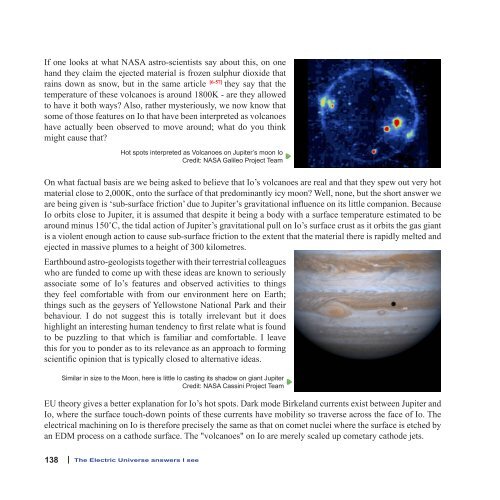A Beginner's View of Our Electric Universe - New
A Beginner's View of Our Electric Universe - New
A Beginner's View of Our Electric Universe - New
Create successful ePaper yourself
Turn your PDF publications into a flip-book with our unique Google optimized e-Paper software.
If one looks at what NASA astro-scientists say about this, on one<br />
hand they claim the ejected material is frozen sulphur dioxide that<br />
rains down as snow, but in the same article [6-57] they say that the<br />
temperature <strong>of</strong> these volcanoes is around 1800K - are they allowed<br />
to have it both ways? Also, rather mysteriously, we now know that<br />
some <strong>of</strong> those features on Io that have been interpreted as volcanoes<br />
have actually been observed to move around; what do you think<br />
might cause that?<br />
Hot spots interpreted as Volcanoes on Jupiter’s moon Io<br />
Credit: NASA Galileo Project Team<br />
On what factual basis are we being asked to believe that Io’s volcanoes are real and that they spew out very hot<br />
material close to 2,000K, onto the surface <strong>of</strong> that predominantly icy moon? Well, none, but the short answer we<br />
are being given is ‘sub-surface friction’ due to Jupiter’s gravitational influence on its little companion. Because<br />
Io orbits close to Jupiter, it is assumed that despite it being a body with a surface temperature estimated to be<br />
around minus 150˚C, the tidal action <strong>of</strong> Jupiter’s gravitational pull on Io’s surface crust as it orbits the gas giant<br />
is a violent enough action to cause sub-surface friction to the extent that the material there is rapidly melted and<br />
ejected in massive plumes to a height <strong>of</strong> 300 kilometres.<br />
Earthbound astro-geologists together with their terrestrial colleagues<br />
who are funded to come up with these ideas are known to seriously<br />
associate some <strong>of</strong> Io’s features and observed activities to things<br />
they feel comfortable with from our environment here on Earth;<br />
things such as the geysers <strong>of</strong> Yellowstone National Park and their<br />
behaviour. I do not suggest this is totally irrelevant but it does<br />
highlight an interesting human tendency to first relate what is found<br />
to be puzzling to that which is familiar and comfortable. I leave<br />
this for you to ponder as to its relevance as an approach to forming<br />
scientific opinion that is typically closed to alternative ideas.<br />
Similar in size to the Moon, here is little Io casting its shadow on giant Jupiter<br />
Credit: NASA Cassini Project Team<br />
EU theory gives a better explanation for Io’s hot spots. Dark mode Birkeland currents exist between Jupiter and<br />
Io, where the surface touch-down points <strong>of</strong> these currents have mobility so traverse across the face <strong>of</strong> Io. The<br />
electrical machining on Io is therefore precisely the same as that on comet nuclei where the surface is etched by<br />
an EDM process on a cathode surface. The "volcanoes" on Io are merely scaled up cometary cathode jets.<br />
13 | The <strong>Electric</strong> <strong>Universe</strong> answers I see


